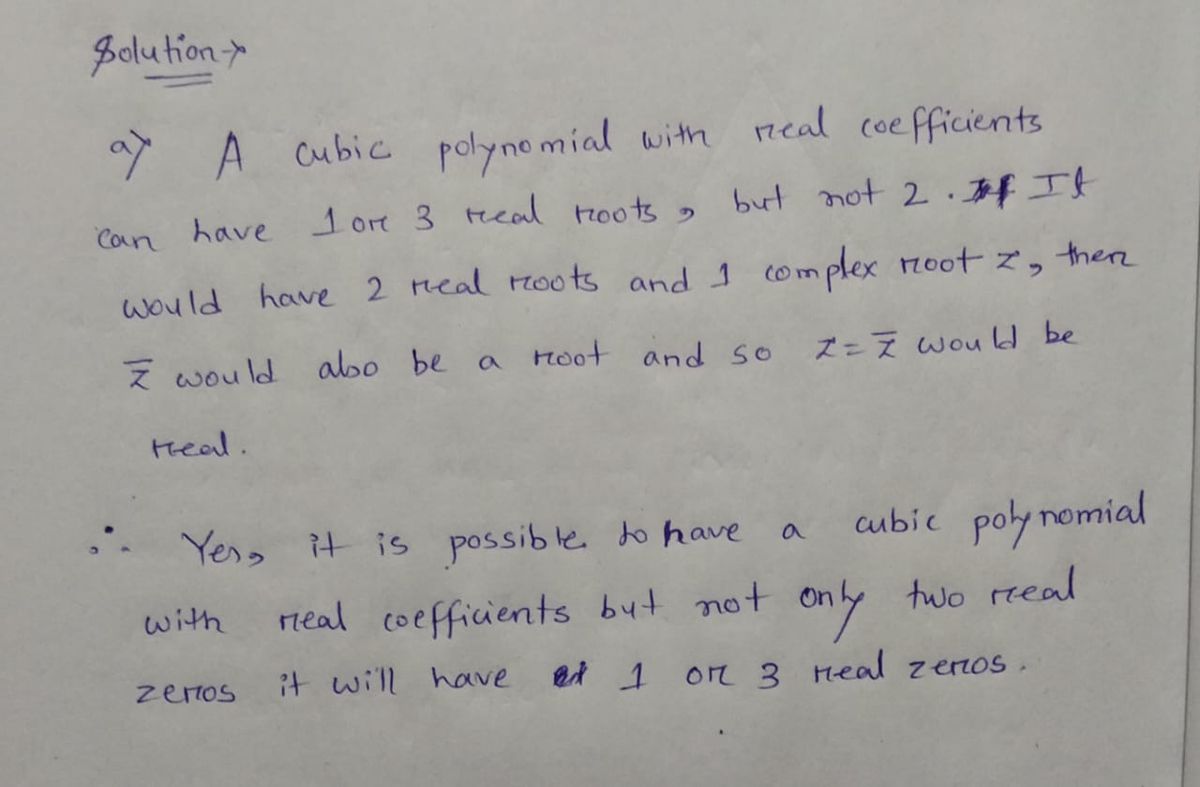Answer the following justifying your answers with examples or by stating theorem(s) used: a) Is it possible to have a cubic polynomial with real coefficients and only two real zeros? b) Does N(x) = 3x* – 5x3 + 3x2 + 1 have any negative real zeros?
Answer the following justifying your answers with examples or by stating theorem(s) used: a) Is it possible to have a cubic polynomial with real coefficients and only two real zeros? b) Does N(x) = 3x* – 5x3 + 3x2 + 1 have any negative real zeros?
Calculus: Early Transcendentals
8th Edition
ISBN:9781285741550
Author:James Stewart
Publisher:James Stewart
Chapter1: Functions And Models
Section: Chapter Questions
Problem 1RCC: (a) What is a function? What are its domain and range? (b) What is the graph of a function? (c) How...
Related questions
Question
Please help

Transcribed Image Text:**Question 3:**
Answer the following justifying your answers with examples or by stating theorem(s) used:
a) Is it possible to have a cubic polynomial with real coefficients and only two real zeros?
b) Does \( N(x) = 3x^4 - 5x^3 + 3x^2 + 1 \) have any negative real zeros?
**Explanation:**
The questions require applying knowledge of polynomial functions and their properties.
- Part a) explores the nature of polynomial roots and the Fundamental Theorem of Algebra, which states that a polynomial of degree \( n \) has exactly \( n \) roots (real or complex) considering multiplicity.
- Part b) involves analyzing the given polynomial to determine if there are any negative real solutions, possibly using techniques such as Descartes' Rule of Signs or other analytical methods.
Expert Solution
Step 1

Step by step
Solved in 2 steps with 2 images

Recommended textbooks for you

Calculus: Early Transcendentals
Calculus
ISBN:
9781285741550
Author:
James Stewart
Publisher:
Cengage Learning

Thomas' Calculus (14th Edition)
Calculus
ISBN:
9780134438986
Author:
Joel R. Hass, Christopher E. Heil, Maurice D. Weir
Publisher:
PEARSON

Calculus: Early Transcendentals (3rd Edition)
Calculus
ISBN:
9780134763644
Author:
William L. Briggs, Lyle Cochran, Bernard Gillett, Eric Schulz
Publisher:
PEARSON

Calculus: Early Transcendentals
Calculus
ISBN:
9781285741550
Author:
James Stewart
Publisher:
Cengage Learning

Thomas' Calculus (14th Edition)
Calculus
ISBN:
9780134438986
Author:
Joel R. Hass, Christopher E. Heil, Maurice D. Weir
Publisher:
PEARSON

Calculus: Early Transcendentals (3rd Edition)
Calculus
ISBN:
9780134763644
Author:
William L. Briggs, Lyle Cochran, Bernard Gillett, Eric Schulz
Publisher:
PEARSON

Calculus: Early Transcendentals
Calculus
ISBN:
9781319050740
Author:
Jon Rogawski, Colin Adams, Robert Franzosa
Publisher:
W. H. Freeman


Calculus: Early Transcendental Functions
Calculus
ISBN:
9781337552516
Author:
Ron Larson, Bruce H. Edwards
Publisher:
Cengage Learning